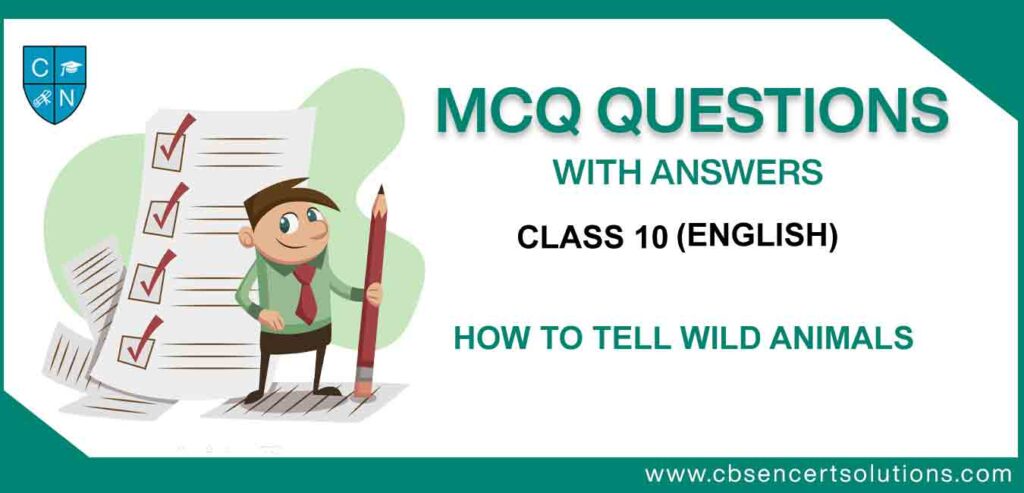Check the below NCERT MCQ Class 10 English How To Tell Wild Animals with Answers available with PDF free download. MCQ Questions for Class 10 English with Answers were prepared based on the latest syllabus and examination pattern issued by CBSE, NCERT and KVS. Our teachers have provided below How To Tell Wild Animals Class 10 English MCQs Questions with answers which will help students to revise and get more marks in exams
How To Tell Wild Animals Class 10 English MCQs Questions with Answers
Refer below for MCQ Class 10 English How To Tell Wild Animals with solutions. Solve questions and compare with the answers provided below
(A) If strolling forth, a beast you view,
Whose hide with spots is peppered,
As soon as he has lept on you,
You’ll know it is the Leopard.
’Twill do no good to roar with pain,
He’ll only lep and lep again.
i Choose the option listing the stanza that would follow the given extract.
a) Option 1
b) Option 2
c) Option 3
d) Option 4

Answer
C
ii Given below are four examples of activities that Jasmeet does. Choose the option that correctly demonstrates ‘strolling’.
a) Jasmeet runs with a great speed after being chased by a dog.
b) Jasmeet walks in the garden, relaxing while listening to his favourite song.
c) Jasmeet skids sharply on the icy skate rink.
d) Jasmeet rushes to switch off the water pump in the backyard.
Answer
B
iii Which option lists the statement that is NOT TRUE according to the extract?
a) The poet asks the reader to hide on seeing the leopard.
b) The poet cautions the reader about a leopard when walking through its territory.
c) The poet informs the reader that a leopard can launch repeated attacks.
d) The poet tells the reader that a leopard attack can result in pain.
Answer
A
iv The repetition used in “he’ll only lep and lep again” is an example of
a) poetic justice.
b) satire.
c) allusion.
d) poetic licence.
Answer
D
v Choose the option that matches with the rhyme scheme of the extract.

a) option 1
b) option 2
c) option 3
d) option 4
Answer
C
(B) Though to distinguish beasts of prey
A novice might nonplus,
The Crocodile you always may
Tell from the Hyena thus:
Hyenas come with merry smiles;
But if they weep they’re Crocodiles
i Choose the option that DOES NOT describe a ‘novice’.
a) Lakshman has played cricket for the first time today.
b) Samiksha has been teaching for last ten years.
c) Srishti went for her first French class yesterday.
d) Gautam baked a second cake to improve his skills.
Answer
B
ii Which option lists the image that DOES NOT indicate what the poet means by ‘beasts of prey’?

a) Option 1
b) Option 2
c) Option 3
d) Option 4
Answer
D
iii What, according to the extract, would cause bewilderment?
a) Discovering the similarity between different preys of beasts.
b) Analysing habits of beasts that prey on hyenas.
c) Knowing the difference between several beasts of prey.
d) Drawing the similarities between crocodiles and hyenas.
Answer
C
iv Choose the line from the given stanza that the poet takes liberty with, to fit to the rhyme scheme.
a) Though to distinguish beasts of prey
b) A novice might nonplus
c) The Crocodile you always may
d) Hyenas come with merry smiles
Answer
B
v Choose the crocodile fact that is related to the given extract.
a) They have webbed feet which, though not used to propel them through the water, allow them to make fast turns and sudden moves in the water or initiate swimming.
b) Absence of sweat glands and so, release heat through their mouths making them often sleep with their mouths open.
c) 99% of crocodiles are eaten in the first year of their life by large fish, hyenas, monitor lizards and larger crocodiles.
d) While eating, they swallow too much air, which gets in touch with lachrymal glands and causes them to weep.
Answer
D

We hope you liked MCQ Class 10 English How To Tell Wild Animals with answers provided above. Incase you have any questions please post them in the comments section below and our English teachers will provide a response.
